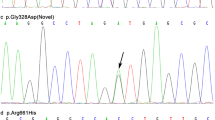Abstract
Backgrounds
Paroxysmal kinesigenic choreoathetosis (PKC) is an autosomal-dominant movement disorder characterized by attacks of paroxysmal involuntary movements. To date, the causative gene has not been discovered.
Purpose
The purpose of the study is to localize the causative region and detect the causative mutation.
Methods
A PKC family including 16 subjects (5 cases and 11 controls) in Zhejiang Province was recruited. Nine microsatellite markers on chromosome 16 were selected and genotyped. Two-point LOD scores were calculated. After preliminary localization, CACNG3, IL4R and ABCC11 were selected as candidate genes and were detected by polymerase chain reaction-sequencing or PCR-denaturing high performance liquid chromatography (PCR-DHPLC).
Results
The maximal two-point LOD score was obtained in D16S3081 with 1.21, and haplotype analysis revealed almost all of individuals carrying 5-3-8-3-4-2-5-5-6 in D16S3093/D16S685/D16S690/D16S3081/D16S3080 D16S411/D16S3136/D16S3112/D16S3057 were affected by PKC. There were no causative mutation in CACNG3, IL4R and ABCC11 genes.
Conclusions
The culprit gene for PKC was located in ~19.34 cM region between 16p12.1–q13, and CACNG3, IL4R and ABCC11 were all ruled out as the cause.



Similar content being viewed by others
References
Baird, N. R., Orlowski, J., & Szabo, E. Z., et al. (1999). Molecular cloning, genomic organization and functional expression of Na+/H+exchanger isoform 5(NHE5) from human brain. Journal of Biological Chemistry, 274, 4377–4382.
Bathia, K. P., Griggs, R. C., & Ptacek, L. J. (2000). Eposodic movement disorders as channelapathies. Movement Disorders, 15, 429–433.
Bennett, L. B., Roach, E. S., & Bowcock, A. M. (2000). A locus for paroxysmal kinesigenic dyskinesia maps to human chromosome 16. Neurology, 54, 125–130.
Bhatia, K. P. (1999). The paroxysmal dyskinesias. Journal de Neurologie, 246, 149–155.
Burgess, D. L., Davis, C. F., Gefrides, L. A., & Noebels, J. L. (1999). Identification of three novel Ca(2+) channel gamma subunit genes reveals molecular diversification by tandem and chromosome duplication. Genome Research, 9, 1204–1213.
Burgess, D. L., Gefrides, L. A., Foreman, P. J., & Noebels, J. L. (2001). A cluster of three novel Ca(2+) channel gamma subunit genes on chromosome 19q13.4: evolution and expression profile of the gamma subunit gene family. Genomics, 71, 339–350.
Cannon, S. C. (2001). Voltage-gated ion channelopathies of the nervous system. Clinical Neuroscience Research, 1, 104–117.
Celesia, G. G. (2001). Disorders of membrane channels or channelopathies. Clinical Neurophysiology, 112, 2–18.
Klein, C., & Vieregge, P. (1998). Non-epileptic paroxysmal movement disorders. Nervenarzt, 69, 647–659.
Margari, L., Presicci, A., Ventura, P., Margari, F., & Perniola, T. (2005). Channelopathy: hypothesis of a common pathophysiologic mechanism in different forms of paroxysmal dyskinesia. Clinical Neurophysiology, 32, 229–235.
Nagamitsu, S., Matsuishi, T., & Hashimoto, K., et al. (1999). Multicenter study of paroxysmal dyskinesias in Japan–clinical and pedigree analysis. Movement Disorders, 14, 658–663.
Ohmori, I., Ohtsuka, Y., Ogino, T., Yoshinaga, H., Kobayashi, K., & Oka, E. (2002). The relationship between paroxysmal kinesigenic choreoathetosis and epilepsy. Neuropediatrics, 33, 15–20.
Sadamatsu, M., Masui, A., Sakai, T., Kunugi, H., Nanko, S., & Kato, N. (1999). Familial paroxysmal kinesigenic choreoathetosis: an electrophysiologic and genotypic analysis. Epilepsia, 40, 942–949.
Sian, D., et al. (2002). Genetic and clinical heterogeneity in paroxysmal kinesigenic dyskinesia: evidence for a third EKD gene. Movement Disorders, 17, 717–725.
Spacey, S. D., Szczygielski, B. I., & McRory, J. E., et al. (2002). Mutation analysis of the sodium/hydrogen exchanger gene (NHE5) in familial paroxysmal kinesigenic dyskinesia. Journal of neural transmission, 109, 1189–1194.
Tammur, J., Prades, C., & Arnould, I., et al. (2001). Two new genes from the human ATP-binding cassette transporter superfamily, ABCC11 and ABCC12, tandemly duplicated on chromosome 16q12. Gene, 273, 89–96.
Tomita, H., Nagamitsu, S., & Wakui, K., et al. (1999). Paroxysmal kinesigenic choreoathetosis locus maps to chromosome 16p11.2–q12.1. American Journal of Human Genetics, 65, 1688–1697.
Valente, E. M., Spacey, S. D., & Wali, G. M. (2000). A second paroxysmal kinesigenic choreoathetosis locus (EKD2) mapping on 16q13-q22.1 indicates a family of genes which give rise to paroxysmal disorders on human chromosome 16. Brain, 123, 2040–2045.
Wein, T., Andermann, F., Silver, K., Dubeau, F., Andermann, E., & Rourke-Frew, F., et al. (1996). Exquisite sensitivity of paroxysmal kinesigenic choreoathetosis to carbamazepine. Neurology, 47, 1104–1106.
Acknowledgement
Authors thank all of the subjects involved in this study. We also thank the Research Fund supported by Natural Science Foundation of Beijing under Grant No.7042037 and Foundation for Innovative Research Groups of the National Natural Science Foundation of China under Grant No.30421003.
Author information
Authors and Affiliations
Corresponding author
Rights and permissions
About this article
Cite this article
Du, T., Feng, B., Wang, X. et al. Localization and Mutation Detection for Paroxysmal Kinesigenic Choreoathetosis. J Mol Neurosci 34, 101–107 (2008). https://doi.org/10.1007/s12031-007-9012-z
Received:
Accepted:
Published:
Issue Date:
DOI: https://doi.org/10.1007/s12031-007-9012-z




